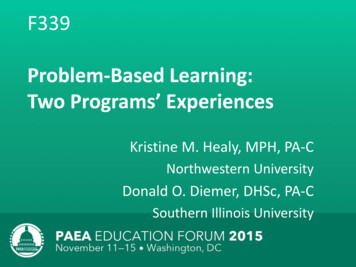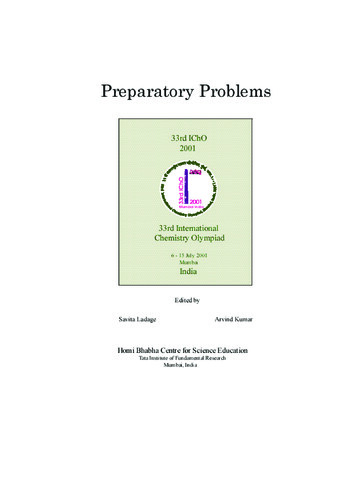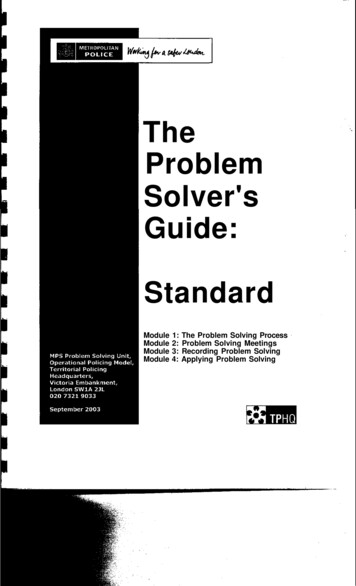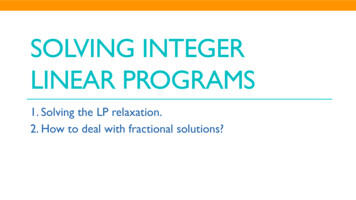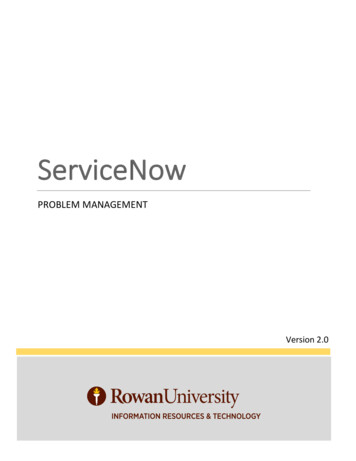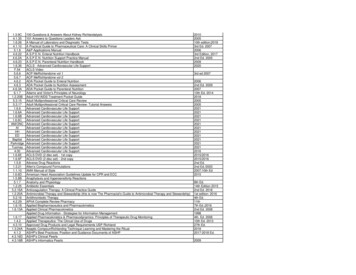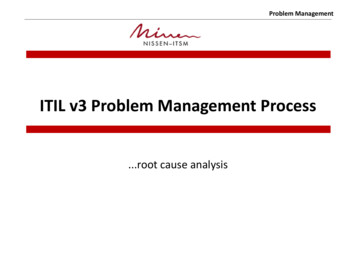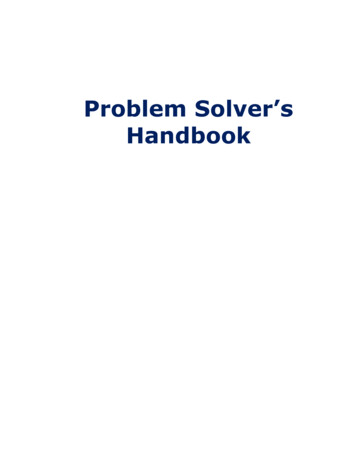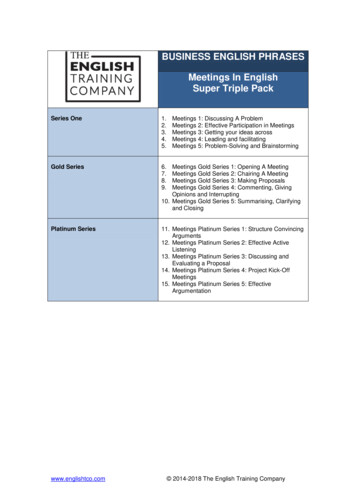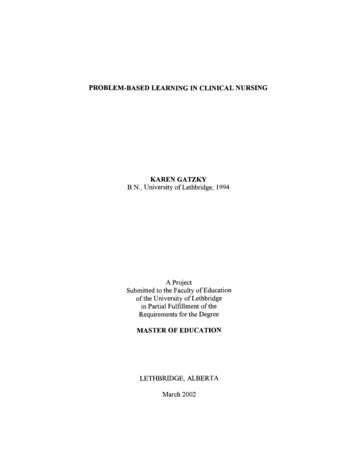
Transcription
PROBLEM-BASED LEARNING IN CLINICAL NURSINGKAREN GATZKYB.N., University of Lethbridge, 1994A ProjectSubmitted to the Faculty of Educationofthe University of Lethbridgein Partial Fulfillment of theRequirements for the DegreeMASTER OF EDUCATIONLETHBRIDGE,ALBERTAMarch 2002
AbstractWhat benefits would problem-based learning (PBL) in nursing have to the clinical settingand would clinical instructor input aid in the successful implementation in the clinicalsetting? The purpose of this study was to research the ways in which PBL could assist inthe clinical nursing setting by exploring the views of instructors directly affected by thisnew process in curriculum delivery at the Southern Alberta Collaborative NursingEducation (SACNE) program. Four sessional clinical instructor interviews wereconducted, each reflecting the four clinical concentration areas offered by the SACNEprogram: (1) Medical/surgical (hospital based), (2) Public/home care (community based),(3) Psychiatry (acute and chronic) and (4) Maternity/pediatrics (hospital based). Theparticipants had a minimum of three years of clinical expertise/experience in the selectedarea. The interviews were both qualitative and quantitative and were conducted over afour-week period. The data analysis was completed by the end of February, 2002. Fromthe four interviews it was evident the clinical instructors had a basic understanding ofPBL but were unsure how to implement it into the clinical setting. Each of the fourclinical areas presented with obstacles that might inhibit successful implementation ofPBL. Several recommendations were suggested that might aid in the successfulimplementation ofPBL in the clinical setting. They addressed necessary resources,implementation strategies, learning strategies and stakeholder concerns.111
Table of ContentsAbstract . .iiiTable of Contents . ivList of Tables . viiIntroduction . 1My Interest In The Topic . 3Others' Interest In The Topic . 4Literature Review . 5Autonomy . 8Self-directed Learning . 9Critical Thinking . 9Facilitation / Collaborative Learning . 10Constructivist Epistemology . 10Metacognition . 11Methodology . 12Research Question . 12Research Tradition . 13Strategies . 15Technique . 18Definitions of Terminology . 19Problems . ,. 19Data Analysis and Discussion . ,. " . ,. ,.,'" " . ,.,' ,. ,. ,. 22Medical/Surgical Interview Data . ,.,.,., . " . 24IV
PubliclHome Care Interview Data . 27Psychiatry Interview Data . 32MatemitylPediatric Interview Data . 36Perceptions of Current Working Context . 38Medical/Surgical. . 39MatemitylPediatrics . 40Psychiatry. 40PubliclHome Care . 41Awareness ofPBL. . 42Medical/Surgical. . 42MatemitylPediatrics . 42Psychiatry. 43Public HealthIHome Care . 43Barriers to PBL Implementation . 44Definitions ofPBL . 45Resources Necessary For PBL Implementation . 47Educational Preference For PBL . 47Recommendations and Conclusions . 48References . 51Appendices . 55A. Consent Letter . 55B. Consent Form . 56C. Interview Guide . 57v
D. Interview Blueprint . 59E. Timelines . " . 61Vi
List of TablesTable1. Medical/Surgical Interview Data . 242. PubliclHome Care Interview Data . 273. Psychiatry Interview Data . 324. MaternitylPediatric Interview Data . 36Vll
IntroductionThe Southern Alberta Collaborative Nursing Education (SACNE) program is anursing education collaborative program between the Lethbridge Community College(LCC) and The University of Lethbridge (U ofL). Prior to the program's initiation inSeptember, 1995, the two educational institutions worked in isolation from one another.Students who successfully completed the LCC Diploma Nursing Program were awardeda Registered Nurse (RN) distinction. RN's from LCC or other institutions, could then goon to pursue a Bachelor of Nursing (BN) designation at The U ofL. Entrance to The U ofL assumed completion of study at the nursing diploma level.The SACNE program allows the nursing student the choice to graduate with anRN following two and a half years of study exclusively at LCC (Diploma Exit Route) orto seamlessly complete four years of study (the first three at the LCC and the final year atthe U ofL), earning a BN. The first four semesters of study are common to both the RNand BN route. Following these foundational four semesters, the students are required toenroll in the RN or BN route, as the next semester heralds the beginning of the SACNEprogram's separate paths of study (Lethbridge Community College Calendar, 2000).With the implementation of the SACNE program, a newly adopted collaborativecurriculum was instituted to meet the expectations of the consolidated program. Thoughthe curriculum had been adopted, with minor revisions to make it more suitable andrelevant to the Chinook Health Region, the process used to implement the curriculumremained unchanged. The LCC continued with a behaviorist / technical model, stressingdecision-making and procedural knowledge. This centered on the perceived necessity toproduce a technically safe practitioner within a compacted two-year program. The1
2opportunities to explore other areas of knowledge, other modes of decision making orother clinical concepts were not available for consideration because of the condensedtime frame in which a program change needed to be implemented. As a result, after fiveyears of trialing the adopted, fragmented, altered curriculum, inadequacies and problemsin meeting the needs of the students and those directly affected by the program surfaced.The collaborative program was recognized as deficient (lacking the necessaryqualities to make it a viable program). Areas of concern surfaced in: fragmentedcurriculum; course sequencing; meeting the needs of the student; meeting the needs ofthose directly affected by the program; accommodating rapidly changing health servicesand changing roles for nurses; and perceptions of nursing leaders within the ChinookHealth Region that some graduate nurses were ill-prepared.As a direct result of these concerns the SACNE program initiated a curriculumreview process aimed at developing a more credible and reputable nursing program. Themodel of curriculum implementation, specifically problem-based learning (PBL),appeared to be the most vital and pivotal decision to the program. It would mandate themethod every instructor would use to facilitate the learning process. This, I felt, wasessential as the role of clinical instruction and supervision revolves around unexpectedand unpredictable events and having a variety of curriculum delivery methods proves tobe an exhausting experience. Clinical nursing education represents one of the mostchallenging aspects of the faculty's role because nursing educators are required to teachcrucial aspects of comprehensive clinical practice in limited time periods and in anincreasingly demanding, high-acuity affiliation sites (Beitz, 1996). This challenge wouldbe more manageable if a curriculum were clearly articulated, with a 'process' for
3curriculum clearly defined, and a focus consistent with relevant theory that correspondedto, supplemented and enhanced the classroom activities. This, ideally, would enhanceinstructional effectiveness while simultaneously helping students make the vital linkbetween theory and practicum.It was with great interest and enthusiasm I chose this topic for my creative projectproposal. The project centered around obtaining feedback from clinical nursinginstructors on how a process-oriented curriculum (PBL) could be successful in theclinical nursing setting. I chose to solicit the views of several instructors directly affectedby the proposed new process of curriculum delivery because I believed they would bemost aware of the costs and benefits of implementation ofPBL in the clinical setting.My concern about and interest in PBL was genuine, as I anticipated the role forclinical instructors would be changed as a direct result of this curriculum restructuring. Iexpected that the more common and familiar practice of teacher-directed learning mightbe transformed into something many clinical instructors would not recognize, or befamiliar with.My Interest In The TopicMy understanding ofPBL is that of a student-centered, experiential learningsituation aimed at developing clinical reasoning, structuring knowledge in real-lifecontexts, motivating learning, and developing self-learning skills. While I amapprehensive in promoting total self-direction and independence in the clinical setting, Iam optimistic that this style of curriculum process has the potential to change the futureeducation of nurses in positive ways, especially in terms of meeting the needs of therapidly changing health care system and the necessity to stay abreast of the constant
4health care advancements. I feel the benefits ofPBL (such things as autonomy, se1fdirection and collaborative learning) do promote higher levels of critical thinking andmetacognition acquisition. In contrast, teacher-directed learning inhibits the developmentof self-motivated, life-long learning skills. If learners were expected to take responsibilityand be active participants in the learning process, one would hope learning would bemore valued and more meaningful.Because PBL was likely to take center stage in the quest to transform the SACNEprogram into an effective process to curriculum delivery, I felt I had an obligation to theprogram and students to be both knowledgeable and cognizant of the issues surroundingthis topic.Others' Interest In The TopicIt was expected the implementation ofPBL would directly affect every clinicalinstructor within the SACNE program. PBL would require a collaborative approachbetween the student and instructor while simultaneously necessitating the instructor to acta facilitator in promoting skills of critical thinking and life long learning. Traditionally,clinical nursing instruction has tended to be an isolated endeavor with minimal feedbackfor the purpose of professional growth. When this is combined with variation in thequality of teaching methods in the clinical setting, it is difficult for the nursing student toremain cognizant of the expectations required from the multitude of instructors. PBL,from a clinical nursing perspective, was expected to provide instructors with a consistentframework to guide practice while meeting the goals and expectations of both theSACNE program and the student.
Literature ReviewA paradigm shift is taking hold in higher education (Barr & Tagg, 1995). "Theparadigm that has governed our colleges is this: A college is an institution that exists toprovide instruction. Subtly but profoundly we are shifting to a new paradigm: A collegeis an institution that exists to produce learning." (Barr & Tagg, 1995, p. 9). Learningstyle has been described as an attribute or characteristic of an individual who interactswith instructional circumstances in such a way as to produce differential learningoutcomes (Linares, 1999). Teacher-directed learning, the student learning strategypresently used at the SACNE program, carries the risk of inhibiting these individualcharacteristics and potentially restricting the quality and quantity of learned knowledge.In April, 2000, the SACNE curriculum committee determined a 'processoriented' approach to curriculum implementation would best suit the needs oftheinstitution. Process-oriented curriculum is supported by the literature as giving studentsthe abilities to acquire skills of critical thinking, problem solving and life-long learning(Rambur, 1999). The process can take many forms but the end result is acquisition ofskill and knowledge in autonomous learning, critical thinking, self-direction providedthrough the non-limiting channels of facilitation, corporative learning, and metacognition(Rambur, 1999). As early as 1978, Abrahamson said there needed to be more thantraditional teacher-directed instruction in nursing education because curriculum wasmuch more than that. "It is dynamic, not static. It is the product of planning andexecution; it varies with its participants, both teachers and learners; it changes in subtleways even when it is apparently unchanging; in short, it has an existence which goesbeyond the concept of a static listing or description of its formal components" (p. 951).5
6Nursing literature has addressed the importance of theory and research in thebaccalaureate curriculum, and professional nursing literature has called for evidencebased nursing practice since the early 1970s (Rambur, 1999). The plea that all nursesmust care enough about their practice to make sure it is based on the best possibleinformation is not new (DiCenso & Cullum, 1998). Although evidence-based nursing hasbeen advocated for years, the struggle with how to make it happen overrides the use of it(DiCenso & Cullum, 1998). The likelihood that evidence-based practice / problem-basedpractice can help ameliorate health care related problems should encourage itsdissemination (Guyatt, Cairns, Churchill, Cook, Haynes, Hirsh, Irvine, Levine, Levine,Nishikawa, Sackett, Brill-Edwards, Gerstein, Givson, Jaeschke, Kerigan, Neville, Panju,Detsky, Enkin, Frid, Gerrity, Laupacis, Lawrence, Menard, Moyer, Mulrow, Links,Oxman, Sinclair, & Tugwell, 1992). However, the barriers to practice continue to inhibitand prevent its use. Time constraints, limited access to the literature, lack of training ininformation seeking and critical appraisal skills, a professional ideology that emphasizespractical rather than intellectual knowledge, and a work environment that does notencourage information seeking (DiCenso & Cullum, 1998) are just a few of the obstaclesthat present this challenge to implementation.Evidence-based nursing is merely one method by which nurses can manage theexplosion of new literature, introduction of new technologies, concerns about health carecosts, and increasing attention to quality and patient outcomes (Kessenich, Guyatt, &DiCenso, 1997). Though the obstacles preventing optimal health care practice seemimmense, one need only reflect on the benefits from the patient perspective in making achange seem justifiable. Kessinich et al (1997) discovered that patients receiving
7researched-based nursing interventions showed sizable gains in behavior, knowledge andpsychological outcomes compared with those receiving routine nursing care.This struggle to incorporate 'process' curriculum and the discovery that a'process' could address rising health care concerns is not unique only to nursing butcommon to all health care professions, including medicine (DiCenso & Cullum, 1998).Based on the awareness of limitations of traditional determinants of clinical decisions, anew paradigm for medical practice has also arisen. Evidence-based medicine deals withsome of the uncertainties of clinical medicine and has the potential for transforming theeducation and practice of the next generation of physicians (Guyatt et aI., 1992). Therewill continue to be an exploding volume of literature, rapid introduction of newtechnologies, deepening concerns about burgeoning medical costs, and increasingattention to the quality and outcomes of medical care (Guyatt et aI., 1992) and what betterway of staying abreast of these challenges than through the use ofPBLIevidence-basedpractice?Evidence-based nursing involves skills of problem definition, searching andevaluation, and the application of original research literature (Kessenich et aI., 1997).Similarly, PBL is a student-centered, experiential learning strategy aimed at developingclinical reasoning, structuring knowledge in real-life contexts, motivating learning, anddeveloping self-learning skills (Baker, 2000). McMaster University School of Nursinghas pioneered problem-based learning curricula and has sustained its evolution bysupporting other nursing facilities in their endeavor to develop problem-based learningpedagogy (Baker, 2000), so there is proof it can be done, and done well.
8AutonomyPractical concerns for professional survival and institutional efficiency tend tooverride pedagogic objections that can be raised against independence in learning(Cornwall, 1988). "A move towards independence in learning and relaxation of someconventional constraints must be associated with greater freedom of choice for thelearner; but, as it seems to be the case for freedom more generally, one may create moregenuine autonomy by imposing a well defined and agreed set of 'rules of the game'"(Cornwall, 1988, p. 245). While I agree autonomy in learning can be productive I alsoagree with Cornwall's statement about 'rules of the game'. There need to be establishedboundaries to ensure content focus and relevance. "Autonomous learning is a process inwhich the learner works on a learning task or activity and is largely independent of theteacher who acts as manager of the learning programme and as resource person" (Higgs,1988, ppAO-41). Under these circumstances the behavior of the learner is characterizedby responsibility for his or her learning, a high level of independence in performinglearning activities and solving programs which are associated with the learning task,active input to decision making regarding the learning task, and use of the teacher as aresource person (Higgs, 1988). Boud (1988) states the notion of autonomy encompassesthree groups of educational ideas:First, it is a goal of education, an ideal of individual behavior to which students orteachers may wish to aspire: teachers assist students to attain this goal. Secondly,it is a term used to describe an approach to educational practice, a way ofconducting courses which emphasizes student independence and responsibility fordecision making. Thirdly, it is an integral part of learning of any kind, no learner
9can be effective in more than a very limited area if he of she cannot makedecisions for themselves about what they should be learning and how they shouldbe learning it: teachers cannot, and do not wish to, guide every aspect of theprocess of learning. (p. 17)Self-directed LearningThere is a link between self-empowerment and self-directed learning (Majumdar,1999). The innovation of self-directed learning was prompted by the fundamental beliefin the importance of nurse empowerment. An empowered nurse is one who has thenecessary knowledge and skills to assume a role in health promotion at the macro-sociallevel and one who is able to teach, counsel and empower the patient (Majumdar, 1999),While Linares (1999) argues that academic success can not be predicted on the basis oflearning style of self-direction, Lindeman (2000) states adult learners are self-directed,highly motivated, goal directed individuals who want active input into the learningprocess. There is a positive relationship between learning style and an individual's selfdirectedness when adaptive flexibility in the context of various learning situations isconsidered (Lindeman, 2000).Critical ThinkingThe realization that knowledge use is as important as knowledge acquisition hasshifted the focus to critical thinking in many disciplines (ONeill & Dluhy, 1997). Criticalthinking is a unique type of purposeful thinking using assumptions, knowledge andcompetence to identify and challenge personal beliefs as one explores and createsalternatives (Sandor, Campbell, Rains, & Cascio, 1998). Nursing educators admissioncommittees must be mindful of which applicants are the most strongly prepared to
10engage in the critical thinking skills necessary for clinical practice (Sandor et aI., 1998).Critical thinking enables the nurse to reason and make judgments about patients(Oermann, 1997). "Critical thinking is a non-linear, recursive process in which a personforms a judgment about what to believe of what to do in a given context" (Oermann,1997, p. 25).Students who demonstrate critical thinking question about care and interventions,demonstrate a willingness to search for answers, are inquisitive and eager to acquireknowledge even if use of this knowledge is not readily apparent, consider multipleperspectives to care, explore ideas and problems in new ways, and are open minded(Oermann, 1997).Facilitation / Collaborative Learning"Humans have a natural potential for learning, and learning will occur if thestudent perceives the subject as important" (Musinski, 1999, p. 29). Learning will occurwhen the adult student is facilitated and made a responsible participant in the learningprocess (Musinski, 1999). Learner-student partnerships within nursing education havehad a tremendous appeal to nurse educators and students because of the emphasis on therelational nature of teaching in which the partners are able to experience a "mutualconnectedness" (Paterson, 1998, p. 288). By integrating cooperative learning experiencesthroughout the curriculum of nursing education, nursing educators and students alikeachieve higher academic outcomes and much, much more (Zafuto, 1997).Constructivist EpistemologyConstructivist epistemology offers an alternative to traditional pedagogy in that itis student-focused and considers previous learning done by the student as a foundation
11upon which to modify, build and expand new knowledge (Peters, 2000). Constructivismappears to be congruent with potential education for the enhancement of self-directedlearning. It enhances empowered learning because of the consideration of priorknowledge and the ownership of learning by the student (Peters, 2000). Implicit in this isthe development of metacognition skills.MetacognitionThe metacognition skills of monitoring, analyzing, predicting, planning,evaluating, regulating, and revising frame the nursing process and support clinicalreasoning (Pesut & Herman, 1992). Nurse educators who encourage metacognition skillacquisition are likely to accelerate student comprehension, understanding, and mastery ofnursing diagnosis, nursing process and clinical reasoning (Pesut & Herman, 1992).Metacognition is a major process by which highly efficient and effective clinical learningcan be enacted (Beitz, 1996). Students with highly developed metacognition arepersonally responsible learners and have skills to cope with future uncertain clinicalproblems (Beitz, 1996).While the literature supports evidence-based practice and PBL as providingautonomous, self-directed, collaborative learning with the potential of enhancing lifelong, metacognitive skills, it fails to familiarize one on how to successfully implementsuch a process in a non-traditional classroom setting. This is where my concern for theSACNE program originated. I felt the implementation of such a process and all thebenefits associated with it might fail if we didn't first explore the perceptions ofthesessional clinical nursing instructors regarding the effectiveness ofPBL in the clinicalsetting.
MethodologyResearch QuestionWhat are the benefits ofPBL for clinical nursing and does a collaborative(inclusion of sessional clinical instructor input) approach aid in its implementation in theclinical setting?I initially began with the intention of carrying through with research based on thehypothesis: Implementing problem-based learning (PBL) in the clinical environmentenhances a student nurse's clinical decision-making skills and promotes self-directedlearning. After conducting my first pilot interview in reference to PBL I realized thegoals of increased clinical decision-making skills and enhanced critical thinking wereovershadowed by how PBL would be implemented into the SACNE program clinicalfield. While it sounded scholarly to enhance student skills, it was not the concern takingcenter stage, as I learned from a close colleague and friend during the pilot interview. Inlight of this revelation I realized a more important task was discovering then addressingthe concerns of those who would be directly affected by the implementation ofPBL inthe clinical setting, the clinical instructors. Thus, my working hypothesis changed to:Discovering and addressing the concerns of the SACNE clinical instructors in referenceto the introduction ofPBL in the clinical setting will aid in its successful implementation.All instructors expected the implementation ofPBL would directly affect them.PBL requires a collaborative approach between the student and instructor.Simultaneously it challenges the instructor to act as a facilitator in promoting skills ofcritical thinking and life-long learning, all in a non-flexible, time pressured clinicalenvironment. Clinical instruction presently tends to be an isolated endeavor with minimal12
13feedback for the purpose of professional growth. Couple this with the many differences inteaching method preferred by each individual instructor and there exists the potential tomake the implementation of a uniform approach to PBL highly difficult, if notimpossible. My initial grandiose idea of enhancing student-centered critical thinking forthe purpose of improving clinical decision-making skills would have little meaning ifthere were no interested or motivated instructors willing to carrying on the essential roleof acting as facilitators to this process. I had little doubt PBL would enhance, strengthenand provide consistency to the quality of learning the student nurse would receivethrough the SACNE program. However, without the cooperation of the clinical staff, anyefforts in that direction might be poi
The Southern Alberta Collaborative Nursing Education (SACNE) program is a nursing education collaborative program between the Lethbridge Community College (LCC) and The University of Lethbridge (U ofL). Prior to the program's initiation in September, 1995, the two educational institutions worked in isolation from one another.
